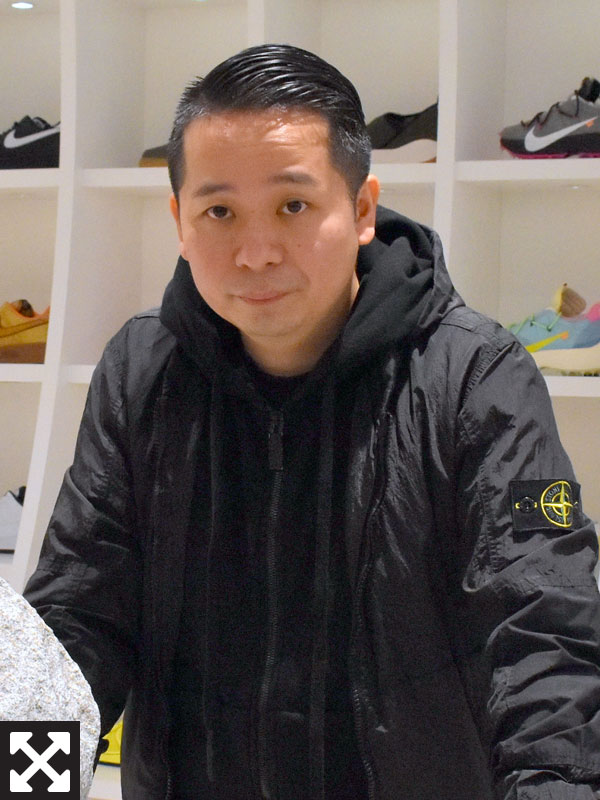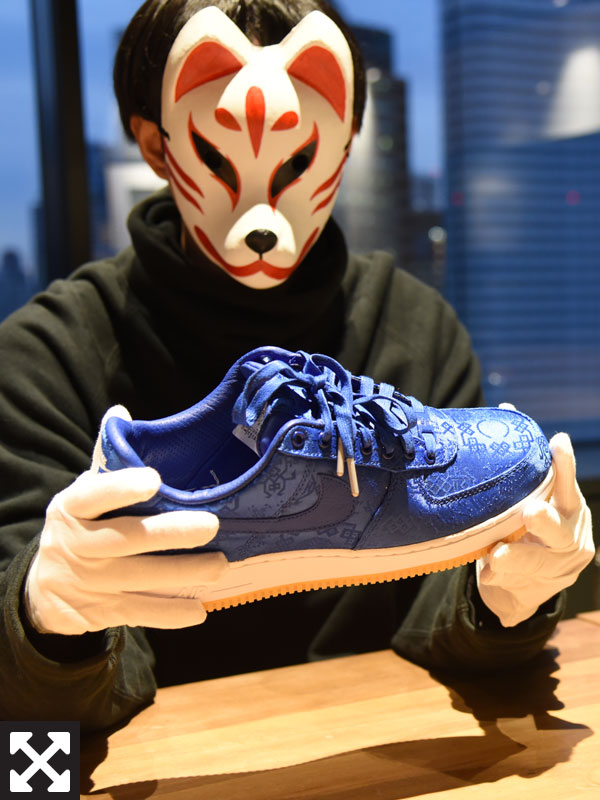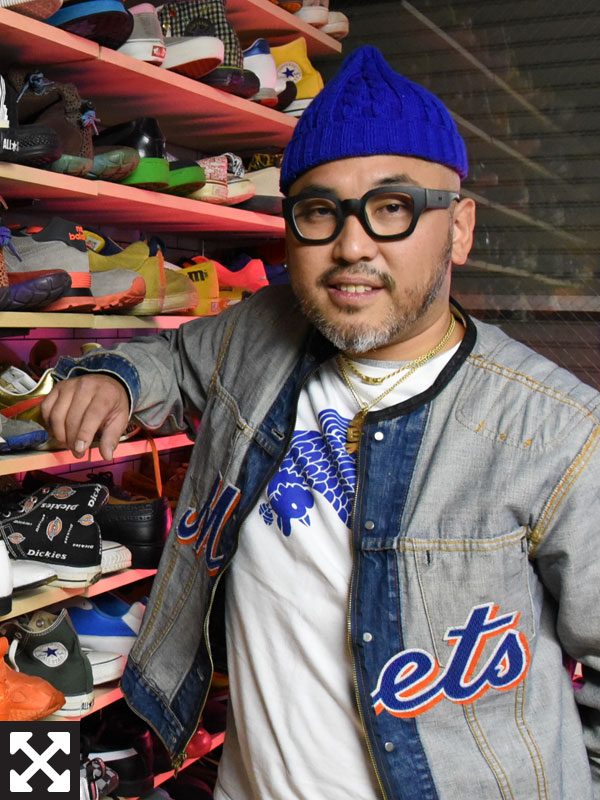LIFE
Just for kicks
Rare gems: Sneakers from Yusuke Takei’s collection. Takei owns around 800 pairs of sneakers. SATOKO KAWASAKI
Global trade in Japan’s limited-edition sneakers is fueling a new wave of interest in the shoes
ANDREW McKIRDY
Staff writer
It’s early morning in Tokyo, only a few years ago, and a large number of homeless people are lining up outside a building in the city’s trendy Harajuku neighborhood.
They aren’t waiting for food bank donations or medical checkups, or to apply for welfare. They are standing in line to buy the latest limited-edition Nike sneakers from a boutique store.
“Some customers were paying homeless people or students to line up outside stores for them,” says Hirofumi Kojima, director of sneaker store Atmos. “Now, we check people’s ID to make sure they don’t do that. And we have a dress code, so you’re not allowed to line up unless you’re wearing a particular type of sneaker. Before we started doing that, you would get hundreds of homeless people lining up on the street.”
Japan’s passion for sneakers is legendary. The popularity of basketball player Michael Jordan helped sneaker culture gain a foothold in the early 1990s, but it was the launch of the Nike Air Max 95 later that decade that really kicked it into the stratosphere.
With sneaker delirium gripping Japan, pairs of Air Max would change hands for hundreds of thousands of yen and legions of “sneakerheads” would line up for days outside stores to buy the latest models. Newspapers even reported cases of people being mugged for their shoes.
The 1990s sneaker craze eventually cooled off, but over the past four or five years a new wave has risen, towering over anything that came before. Now, limited-edition models sell for eye-watering sums on internet resale sites, and the fashionable shopping districts of Tokyo chime with the sound of ringing tills as customers rush to seek out the hottest items.
“The first sneaker boom in Japan started in the 1990s, but that was very much something for a small group of people who were interested in it — for collectors,” Kojima says. “Now, people all around the world share an interest in sneakers. They’ve become part of the fashion world. This year, there are collaborations between Christian Dior and Jordan, and Adidas and Prada. Things are happening that you never would have imagined. Sneaker culture has become much more established.”
Atmos became Japan’s first boutique sneaker store when it opened in Harajuku in 2000 and now has around 30 branches nationwide, as well as one in New York, two in South Korea, two in Thailand and one in Indonesia. The company will also open stores in Malaysia and the Philippines this summer.
Kojima estimates that around half the customers at some of the Tokyo stores are from overseas, drawn by the city’s reputation as a global sneaker mecca.
“There are lots of places to buy sneakers in Tokyo,” says Yuki Kakiuchi, a hot dog shop owner who has around 300 pairs of sneakers and describes himself as a “sneakers influencer.” “They’re easy to get to, and they’re comparatively cheap. Young people who live in Los Angeles can go to the mall but they can’t really go to Melrose Avenue. In Tokyo, you can get on the train and go to Shibuya, Harajuku, Daikanyama, Ebisu — anywhere.”
Sneakers on display at Atmos. SATOKO KAWASAKI
Yusuke Takei, a 43-year-old company worker who lives in Matsudo, Chiba Prefecture, is from Japan’s original generation of sneakerheads. He first became hooked when he saw Jordan playing basketball in elementary school, and started collecting sneakers seriously when he was a university student. Now, he owns around 800 pairs, roughly 600 of which are Nike Air Force One models.
Takei keeps around 200 pairs at his parents’ house nearby, although he admits they’re not particularly happy about that arrangement. His own house is stacked from floor to ceiling with shoeboxes, and he concedes that he might have to slow things down a little after he gets married later this month.
“I haven’t been buying a huge amount recently,” Takei says. “I’d say I buy about one or two pairs a month. I only buy one pair of each model. I used to buy more than one — one to wear and one to have as stock — but I have a lot of shoes already, so it’s not like I’m going to wear out the pair I’m using.
“I wear most of my sneakers,” he adds. “I don’t put the ones I don’t wear on display. I leave them in the box. Sometimes I’ll take them out and have a look at them. Sometimes they’ll appear in magazines, or I’ll lend them to exhibitions.”
The crown jewel in Takei’s collection is a 35-year-old original pair of Air Jordan 1s in red, white and black. The most he has ever paid for a pair of sneakers is ¥120,000.
Takei does most of his shopping online nowadays, but he has fond memories of hunting out sought-after sneakers in the pre-digital age. In order to find out when new releases went on sale, he had to cultivate relationships with the people who worked in the stores. Sometimes, if he was on especially good terms with them, they would put a pair aside for him if he couldn’t get to the store early enough.
“Then the internet became more widespread and it became a means of buying and selling,” Takei says. “Everyone could find out when something would go on sale and at which stores. Then it stopped being about who got there first, because stores started having lotteries to decide who got to buy them.
“It used to be that I would go to a store where I would know the people who worked there and I would spend time speaking to them,” he says. “Now the people who work in the stores change all the time. The pleasure of going to the same place has gone.”
Some stores have introduced gimmicks to encourage buyers to shop in person, such as quizzes, puzzles and treasure hunts around Tokyo neighborhoods, with participants given the chance to buy limited-edition shoes as prizes.
Yuuki Kakiuchi's sneaker collection. SATOKO KAWASAKI
For many customers in 2020, however, shopping for sneakers is more than just fun and games. The growth of the resale market and the huge increase in limited-edition models in recent years has made buying and selling a very lucrative business indeed.
Limited editions, often the product of collaborations between sneaker makers and fashion designers or musicians, are released in small quantities usually designed to sell out in less than a day. Kojima estimates that a new sneaker is released on every day of the year.
Rare, in-demand sneakers can be sold on resale sites like StockX or GOAT for many times their original value, giving rise to an international generation of business-minded global sneaker speculators a world away from the obsessive collectors of the 1990s.
“The customers nowadays are completely different,” Kojima says. “Our job at Atmos is to explain the story of a sneaker to the customer — why it’s a particular color, and so on. Now, the first thing the customers want to know is, ‘Is this a limited edition?’ or, ‘Is this rare?’ That’s not so bad if it’s something that gets them into sneakers. But I’d prefer that they had more interest in it.”
When you make your living from trading sneakers as if they were stocks and shares, however, you had better make sure you get your hands on the coveted goods when they hit the stores.
Lining up to buy newly released sneakers was once something of a hazardous activity, with the threat of violence and robbery — even in normally safe Japan — adding to the hardship of standing on the street for what could be days on end.
Trouble nowadays is not unheard of, but stores operate a lottery system rather than a first-come, first-served basis, and they also enforce a sneaker-based dress code and demand to see identification to prevent would-be shoppers from employing surrogates to line up for them.
“We had 1,200 people lining up here recently,” Kojima says. “If we hadn’t had a dress code, it would have been 3,000 or 4,000.”
The high demand for limited-edition sneakers means only a chosen few will be able to buy them through official retailers such as Atmos. The rest must find them on resale sites, which do not come with the same guarantee of authenticity.
Counterfeit sneakers have been around for practically as long as the genuine articles themselves, but in recent years they have reached unprecedented levels of sophistication. As the global sneaker market continues to grow, so does the number of convincing-looking fakes in circulation.
Step forward Fake Busters, Japan’s first third-party sneaker authentication company, which launched in April 2019 and had already racked up 40,000 orders by the end of last year.
Fake Busters offers two authentication services. The quick service costs from ¥550 and asks customers to send a photograph of their sneakers to Fake Busters’ team of experts, who then assess the shoes within 48 hours and issue a certificate if they are satisfied that they are genuine. The complete service costs from ¥2,000 and requires the customer to send their sneakers to Fake Busters’ authenticators, who will attach a verification tag with a serial code if they judge them to be real.
“When people buy things on Mercari or Rakuten Global Market or Yahoo Auctions, they don’t know whether the goods are real or fake when they arrive,” says Fake Busters CEO Yoshio Aihara. “It’s been that way for a long time. If you’re thinking of buying a pair of sneakers that cost ¥100,000 and you’re not sure whether they’re going to be genuine or not, you might just decide not to buy them. Even when they arrive, you feel anxious about whether they’re real or not.
“In Japan, there’s a culture of strongly feeling that an item has to be genuine,” Aihara says. “No wants to buy a fake. It’s expensive. If you’ve paid ¥100,000 for something and you’ve been duped, you feel bad about it.”
Aihara says the most important qualification to join Fake Busters’ team of around 20 authenticators is to be familiar with the fakes — overwhelmingly produced in China — rather than the originals. Some of the authenticators have inside information on the workings of the counterfeit factories and the company has an extensive database of reference materials.
The authenticator is looking for tiny details like the stickiness of the adhesive on the underside of the insole, the size and spacing of the lettering on the label, or the quality of the thread used in the stitching. This specialist knowledge is acquired through study and experience, but also carries certain risks.
“There are a lot of people who make fake goods, and they view the authenticators as the enemy,” says Aihara. “We’re exposing their goods as fakes, so the authenticators get a lot of threats. There’s bribery. They get threats against their families. If they show their faces, people might check and find out their names and addresses. It’s dangerous for them to show their faces.”
Aihara says the authenticators can sometimes tell within seconds if sneakers are genuine or fake, but often they will have to pore over reference materials before they can make a final decision. The company will not issue a verification tag unless the authenticators are 100 percent sure the sneakers are genuine, and will refund the customer’s money if they cannot reach a verdict.
“You have to build trust one step at a time,” says Aihara. “We have to establish a body of work and make no mistakes. Our customers will feel that Fake Busters has helped them out or given them some peace of mind.”
Clearly, much has changed for Tokyo’s sneaker scene over the past 30 years. What started as a niche concern for a small group of enthusiasts has mutated into a behemoth, fed by ravenous consumers, ruthless business tactics, an unfettered market and, of course, lots and lots of money.
Some of Japan’s original sneakerheads express dismay at the way things have turned out. “Sneaker influencer” Kakiuchi, whose house in Tokyo’s Meguro Ward looks like the interior of a Harajuku streetwear shop — complete with giant plastic dinosaur heads, neon beer signs on the walls and stacks of sneakers on the shelves — thinks there is little originality or individuality around nowadays.
When the wrapping has been peeled away and only the pure essence of sneaker culture remains, however, not even the most jaded of collectors can deny the feeling that comes with lifting a fresh pair out of the box.
“Just thinking about buying sneakers gets you excited,” Kakiuchi says. “You buy them and you’re excited, then you go to bed and get up excited. It’s like being a kid again, getting a Christmas present. You’re excited before you get them and again after you get them. With sneakers, you can get that feeling every time for ¥10,000 or ¥20,000.”





